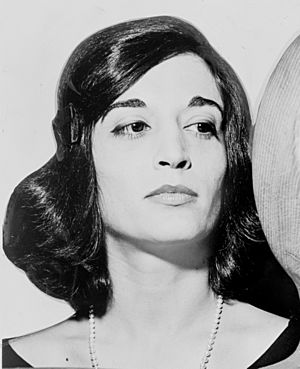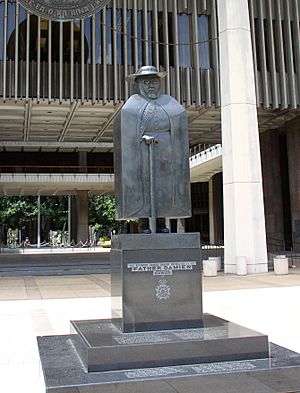Marisol Escobar facts for kids
Quick facts for kids
Marisol Escobar
|
|
|---|---|

Marisol Escobar (1963)
|
|
| Born |
Maria Sol Escobar
May 22, 1930 Paris, France
|
| Died | April 30, 2016 (aged 85) New York City, US
|
| Education | Jepson Art Institute École des Beaux-Arts Art Students League of New York Hans Hofmann School |
| Known for | Sculpture Assemblage |
|
Notable work
|
Women and Dog The Last Supper Dust Bowl Migrants Father Damien |
| Movement | Pop Art, New Realism |
| Awards | 1997 Premio Gabriela Mistral, from Organization of American States American Academy of Arts and Letters (1978) |
Marisol Escobar (born May 22, 1930 – died April 30, 2016) was a famous Venezuelan-American artist. She was known simply as Marisol. Born in Paris, France, she lived and worked in New York City. Marisol became very well-known in the mid-1960s for her unique sculptures. After a period where her work was less seen, she became famous again in the early 2000s. A big art show of her work happened in 2014.
Contents
Early Life and Art Training
Maria Sol Escobar was born on May 22, 1930, in Paris. Her parents were from Venezuela and came from rich families. They earned money from oil and real estate. Because of their wealth, Marisol's family traveled a lot. They visited Europe, the United States, and Venezuela. At some point, Maria Sol started using the nickname Marisol.
When Marisol was eleven, her mother passed away. This was a very difficult time for her. After this, Marisol decided not to speak much. She only spoke when she had to, like to answer questions at school. She didn't regularly speak out loud until she was in her early twenties.
Even though she faced challenges, Marisol's artistic talent was clear from a young age. She loved to draw, and her parents encouraged her by taking her to museums. She often won art prizes at the different schools she attended. In 1946, her family moved to Los Angeles.
Marisol was also very religious when she was a teenager. She found ways to cope with her mother's death through her faith.
After her mother's death, Marisol's family traveled between New York and Venezuela. In 1946, when she was 16, they moved to Los Angeles for good. She went to Marymount High School and later the Westlake School for Girls.
Marisol began her art education in 1946. She took night classes at the Otis Art Institute and the Jepson Art Institute in Los Angeles. She studied with artists like Howard Warshaw. In 1949, she studied art in Paris at the École des Beaux-Arts. Later, she returned to New York to study at the Art Students League of New York and with artist Hans Hofmann.
Becoming a Pop Artist
In the 1960s, Marisol became a part of the Pop Art movement. This helped her become more famous. She focused on making three-dimensional portraits. She often found ideas in photos or her own memories. Marisol also used everyday objects in her art. For example, a piece of wood became her Mona Lisa sculpture. An old couch became her artwork called The Visit.
She became friends with the famous artist Andy Warhol in the early 1960s. Marisol even made a sculpture of him. Warhol asked her to be in his early films, The Kiss (1963) and 13 Most Beautiful Girls (1964).
Marisol was influenced by Pop artists like Andy Warhol and Roy Lichtenstein. One of her most famous works from this time is The Party. This artwork shows a group of life-sized figures. They are gathered together, dressed like people from high society. All the figures in The Party have Marisol's own face. Marisol decided to drop her family name, Escobar. She wanted to be known just as Marisol and stand out.
Marisol's art was unique. She didn't fit into just one art style. One art critic wrote, "Not Pop, Not Op, It's Marisol!" She was known for being quiet and not talking much about her career. She once said, "I have always been very fortunate. People like what I do."
In 1966-67, she made a sculpture of Hugh Hefner. He was a well-known magazine publisher. She showed him with two of his famous smoking pipes. One was painted, and a real one stuck out from the sculpture. This artwork was even on the cover of Time magazine in 1967. It is now in the National Portrait Gallery in Washington, D.C. A museum expert said Marisol used humor to make people think differently about art. When asked why there were two pipes, Marisol said, "Well, Hugh Hefner has too much of everything."
Marisol often included portraits of famous people, family, and friends in her sculptures. She also made a life-sized sculpture of herself looking at her large artwork of The Last Supper. This showed her respect for Leonardo da Vinci.
Later Career and Recognition
Marisol's image is part of a famous 1972 poster called Some Living American Women Artists.
Art experts began to see Marisol as an important Pop artist around 1965.
Marisol received several awards for her art. In 1978, she was chosen to be a member of the American Academy of Arts and Letters. In 1997, she received the Premio Gabriela Mistral from the Organization of American States. This award recognized her contribution to culture in the Americas.
In the 1990s, Marisol created sculptures mostly of Native Americans. These works were not always understood by everyone.
In 2004, Marisol's art was shown in an exhibition called "MoMA at El Museo." This show featured Latin American artists. More recently, people have become very interested in Marisol's work again. A big show of her art happened in 2014 at the Memphis Brooks Museum of Art. This show also became her first solo exhibition in New York City.
Last Years
Marisol lived in New York City in her later years. She had health issues, including Alzheimer's disease. She passed away on April 30, 2016, at the age of 85, from pneumonia.
In 2017, it was announced that Marisol left all her art and belongings to the Albright-Knox Art Gallery in Buffalo, New York.
In 2022, the Pérez Art Museum Miami held a special exhibition. It was called Marisol and Warhol Take New York. This show looked at how both Marisol and Andy Warhol became famous artists.
Art Collections
Marisol's artworks are kept in many important museums. Some of these include the Pérez Art Museum Miami, the Albright-Knox Art Gallery, The Metropolitan Museum of Art, the Currier Museum of Art, ICA Boston, and the Museum of Modern Art.
Awards
- 2016 Paez Medal of Art from VAEA (awarded before her death, given after she passed away)
See also
 In Spanish: Marisol Escobar para niños
In Spanish: Marisol Escobar para niños


